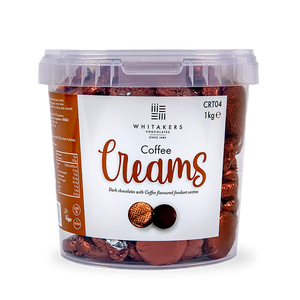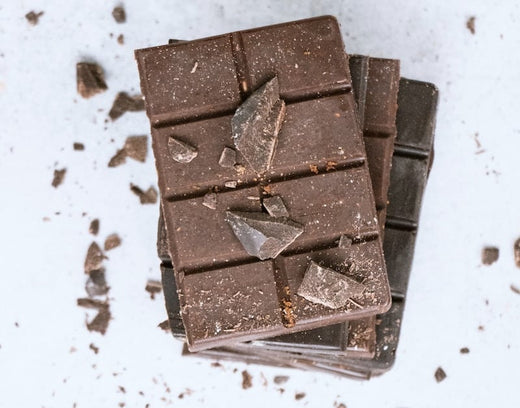We're all familiar with the classics: dark, milk, white, and even the increasingly popular blonde chocolate.
But have you ever heard of 'compound chocolate'?
While it may not have the same name recognition, you've probably encountered it more often than you realise, especially in commercially produced sweets and treats.
Compound chocolate is an affordable alternative to traditional chocolate, often used in mass-produced products or in baking.
But what exactly is it, and how does it differ from the chocolate we know and love? Is it a lesser substitute, or does it hold its own in the world of confectionery?
In this post, we're going to delve into the ins and outs of compound chocolate: what it is, how it's made, and where it's used.
What Is Compound Chocolate?
Compound chocolate is a type of chocolate substitute that's made from a combination of cocoa, vegetable fat, and sweeteners.
It's designed to mimic the flavour and texture of real chocolate, but it replaces the cocoa butter found in traditional chocolate with less expensive fats, such as palm oil or coconut oil.
Compound chocolate is often used in commercial baking and confectionery due to its lower cost and its ease of use.
What Are the Ingredients in Compound Chocolate?
Compound chocolate is made from a mixture of ingredients designed to emulate the taste and texture of genuine chocolate.
The primary ingredients include:
-
Cocoa: This can be in the form of cocoa powder or cocoa solids, giving the compound chocolate its chocolatey flavour.
-
Vegetable Fat: Instead of ccoa butter, which is used in traditional chocolate, compound chocolate utilises less expensive vegetable fats, such as palm oil, coconut oil, or soybean oil.
-
Sweeteners: These can range from granulated sugar to high-fructose corn syrup or other types of sugar substitutes.
-
Emulsifiers: These are often added to improve the texture and consistency of the compound chocolate.
-
Flavours: Additional flavours, like vanilla, may be added to enhance the taste.
It's important to note that while compound chocolate attempts to mimic the flavour and texture of genuine chocolate, the quality and taste can vary widely depending on the quality and proportions of the ingredients used.
(You might also be interested in taking a look at this post asking: How Much Sugar is in a Chocolate Bar?)
What’s the Difference Between Real Chocolate and Compound Chocolate?
The main difference between normal chocolate and compound chocolate lies in their ingredients and the manufacturing process.
-
Ingredients: Normal chocolate, whether it's dark, milk, or white, contains cocoa butter, which is the natural fat present in cocoa beans. This gives chocolate its unique, creamy texture and flavour. On the other hand, compound chocolate replaces cocoa butter with less expensive vegetable fats, such as palm or coconut oil.
-
Taste and Texture: While compound chocolate is designed to taste similar to real chocolate, the substitution of fats often results in a different flavour profile and texture. Normal chocolate typically has a richer, deeper flavour and a smoother mouthfeel compared to compound chocolate.
-
Tempering: Normal chocolate requires a process called 'tempering', where it's carefully heated and cooled to give it a glossy finish and a good 'snap'. Compound chocolate, however, doesn't require tempering, which makes it easier to work with, especially in commercial or high-volume baking.
-
Cost: Due to the use of less expensive fats instead of cocoa butter, compound chocolate is generally cheaper than normal chocolate.
-
Applications: Compound chocolate is often used in mass-produced chocolates, candy coatings, and in baking due to its ease of use and lower cost. Normal chocolate is typically used when a higher quality, richer flavour, and smoother texture are desired.
In summary, while both have their uses, normal chocolate and compound chocolate offer different experiences in terms of taste, texture, and culinary applications.
(Take a look at this post if you would like to read about: What is Semi-Sweet Chocolate?)
Which Tastes Better Real Chocolate or Compound Chocolate?
The taste of real chocolate compared to compound chocolate is a subject of considerable debate.
However, many people - particularly chocolate connoisseurs - would argue that real chocolate has a superior taste, and there's good reason for this.
Real chocolate contains cocoa butter, the natural fat found in cocoa beans, which gives it a rich, smooth texture and a depth of flavour that is hard to replicate.
The cocoa butter melts at just below body temperature, which is why real chocolate has that wonderful melt-in-your-mouth quality.
Moreover, the balance of sweetness and bitterness in real chocolate creates a complex flavour profile that is deeply satisfying.
On the other hand, compound chocolate substitutes cocoa butter with other vegetable fats.
While this can make the chocolate easier to work within certain applications, it often results in a different, less satisfying texture and flavour.
The melting point of the fats used in compound chocolate is usually higher than body temperature, which means it doesn't melt as luxuriously in your mouth.
The flavour can also be less nuanced, as it lacks the depth and complexity provided by cocoa butter.
At Whitaker's Chocolates, we firmly believe in the superiority of real chocolate.
That's why we only use real chocolate in our products, made with 100% natural ingredients and Fairtrade cocoa.
We're committed to creating chocolates that not only taste fantastic, but also adhere to ethical and sustainable practices.
Our dedication to quality is evident in every delectable piece of chocolate we produce, delivering a taste experience that is as rewarding as it is indulgent. It's not just about making chocolate - it's about crafting moments of joy with every bite.
(Click here if you want to read about blonde chocolate).
What is Compound Chocolate Used For?
There are several uses for compound chocolate:
-
Baking and Cooking: It's frequently used in baking and cooking because it's less expensive than real chocolate. It's also easier to work with, as it doesn't require tempering as pure chocolate does. This makes it a popular choice for many recipes, including cookies, brownies, and cakes.
-
Coatings and Candies: Compound chocolate is often used for candy coatings due to its smooth texture and the fact that it melts easily and then hardens quickly. This makes it ideal for making chocolate-covered treats like nuts, fruits, or biscuits.
-
Decoration: Since it can easily be melted and moulded, compound chocolate is often used for decorating desserts. You'll find it used in garnishes, intricate dessert designs, and more.
-
Industrial use: Compound chocolate is widely used in large-scale, industrial food production due to its cost-effectiveness and ease of use.
While compound chocolate doesn't provide the same rich, complex flavours, you'd get from high-quality chocolate, its convenience and versatility make it a popular choice for many culinary applications.
(Click here if you want to read about: What is Raw Chocolate?)
Where Can You Buy Tasty Chocolate?
For anyone seeking delectable, high-quality chocolate, look no further than Whitaker's Chocolates.
With a rich heritage and a commitment to exceptional craftsmanship, we’ve been delighting chocolate lovers for generations.
As a family-run business, Whitaker's brings years of expertise to each chocolate it produces, ensuring every bite is a testament to its dedication to quality.
This commitment extends beyond taste to sustainability and ethical sourcing.
We proudly use Fairtrade cocoa across our entire range, which not only ensures a fair deal for cocoa farmers in developing countries but also contributes to sustainable farming practices.
Taking pride in the ingredients we use, Whitaker's chocolates are crafted from only the finest natural ingredients.
There's no room for anything nasty here.
Unlike some other brands, you won't find artificial additives or preservatives in Whitaker's chocolates. Instead, you'll find pure, delicious ingredients that create a memorable tasting experience.
Moreover, we’re dedicated to inclusivity, creating a variety of chocolate delights to cater to different dietary requirements.
Many of our offerings are gluten-free and palm oil-free, making them a great choice for those with specific dietary needs.
We also have a range of products suitable for vegetarians and vegans, so everyone can enjoy the rich, mouth-watering taste of their chocolates.
In short, Whitaker's is not just a chocolate brand - it's a promise of quality, sustainability, and an absolute delight.
When you choose Whitaker's, you're not just buying a chocolate bar; you're choosing a product that stands for responsibility, inclusivity, and, above all, a love for great-tasting chocolate!
Here’s some of our firm customer favourites:
- We’re the masters of mint, so it’s not surprising that our dark chocolate mint fondant creams are a top seller!
- Show to love, with our creamy milk chocolate red foiled hearts
- A great taste award winner, our iconic dark chocolate ginger wafer thins are truly delicious
- A touch of luxury, beautifully presented gift box filled with hand finished chocolate truffles
- Knock your socks off with our fiery combo of dark chocolate bar infused with orange and chilli
Final Notes On Compound Chocolate
Compound chocolate is a cost-effective alternative to traditional chocolate, widely used in commercial confectionery and baking due to its affordability and ease of handling.
It mimics the taste and texture of real chocolate, utilising a blend of cocoa, vegetable fats, sweeteners, emulsifiers, and additional flavours.
However, it's essential to remember that the substitution of cocoa butter with other vegetable fats in compound chocolate does impact the taste, texture, and overall quality.
Real chocolate, with its cocoa butter content, offers a richer flavour profile and a smoother, more satisfying mouthfeel.
This superiority in taste and texture is why many prefer real chocolate and why esteemed chocolatiers, like Whitaker's Chocolates, exclusively use real chocolate in their products.






















